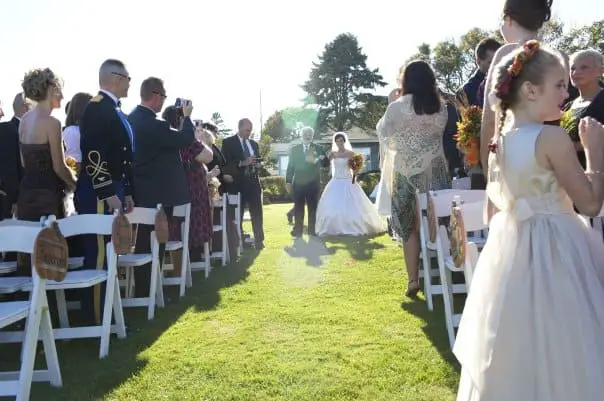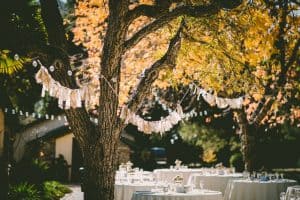As I was researching for this article, trying to put together the “perfect” wedding ceremony order of events, I realized something: There is no “perfect” order of events and there is no sequence of events that you “have to do” on your wedding day.
You only need to do what feels right for you and your partner. And that probably means taking into account your specific cultural and religious practices, as well as your personal preferences — instead of simply following an order of events from a blog you read online, or even from weddings that you’ve been to personally as a guest.
Many of the templates I came across online did not mention that there are SO MANY different ways of doing a wedding ceremony, within the U.S. and Canada and around the world. If you’re writing your own wedding ceremony from scratch, I suggest you also read my article on how to write a wedding ceremony script in 10 easy steps!
PRO TIP: How long should a wedding ceremony be? Wedding ceremonies are usually anywhere from 15 minutes to an hour long, but keeping them at about 30 minutes is the ideal length for a wedding ceremony. You don’t want them to be too fast, nor do you want your guests to start to fall asleep!
How a wedding is “supposed to go” often means upholding traditional gender roles…
And we don’t have to do that!
The wedding ceremony sequence of events we have mimicked in our own lives and seen reflected in popular culture for years usually involves heterosexual couples and weddings that have single-sex wedding parties.
However, these days, in attending the weddings of our families and friends, we realize that there are A LOT more options out there than traditional bridal guides would have us believe. For couples and wedding parties of all genders!
When we look at the weddings of same-sex couples, for example, we may realize that the roles we’ve placed on men and women in heterosexual ceremonies aren’t necessary — and many couples may want to do something that feels more equal… or at least more “them.”
So this article will give a very basic outline of what has happened historically/traditionally at many so-called “typical” weddings 🙂 …but I want to emphasize that these ceremony practices CAN and SHOULD be changed to reflect the couple who’s getting married.
No one has to have an all-female bridal party, for example. Or walk down the aisle with their dad. Or even walk down an aisle at all! The possibilities are endless! 🙂
In you’re interested, you can also check out the video I made about this topic on my wedding YouTube channel.
A “Typical” Wedding Ceremony
Here’s a step-by-step wedding ceremony template that has often been used, which you may want to use as a basis from which to create a wedding ceremony that works best for you and your partner:
The Processional
This is essentially when the wedding party and the couple enters the ceremony space… ceremoniously! So, traditionally, the groom wouldn’t get a big or main entrance for himself. He’d enter with his mom or perhaps the officiant at the beginning of the processional.
This is followed by the entrance of the wedding party. Some couples like to have their bridesmaids and groomsmen enter arm-in-arm, or sometimes one at a time down the aisle.
The flower girl and ring bearers often come next. Fun alternatives these days include involving your dog in one of these roles, or maybe asking your grandmothers to be flower girls!
Finally, the bride is traditionally escorted down the aisle by her dad, as the guests all stand and the groom watches her walk down toward him. Often the dad will kiss and embrace his daughter, shake his soon-to-be son-in-law’s hand, and leave the couple at the altar.
Music for the processional can be whatever you want it to be, with many couples carefully choosing the songs that the wedding party and the bride walk down the aisle to. Instrumental versions of popular songs seem to be most popular these days.
The Opening Remarks/Opening Prayer
Once the couple is together at the altar, the officiant gives some opening remarks. Or if it’s a religious ceremony, the officiant might begin with an opening prayer.
This is where it’s good to have either a professional or a person who has public speaking experience, to do the officiating. A shy or uncomfortable public speaker is obviously going to struggle in this role. But I have said before that I think you SHOULD choose someone to officiate your wedding who knows you and loves you, and not some generic person who may forget your names. If possible.
The opening remarks can either be written by you (you can use my ceremony-writing guide here to help you — opening remarks are Step #6!) or you can choose to let the officiant write them. It’s up to you! You can also choose to be surprised or you can ask the officiant to share their opening remarks with you before your wedding day so that you can approve them or make changes.
Opening remarks generally welcome the guests, give a brief overview of why we’re all here today and what we’ll be witnessing, perhaps a short and sweet story about the couple, and that’s that!
The Readings
Readings are an interesting part of the ceremony in that, they can actually be really interesting and reflective of who you are as a couple… or they can be a totally boring missed opportunity that make your guests zone out for a few minutes.
Traditionally, you would choose one or two people close to you, either in the wedding party or not, to come up to the front and read a pre-chosen poem, piece of scripture, book excerpt, or any other piece of writing that is meaningful to you as a couple… and each reading should only be a few minutes TOPS.
I would suggest that you do ONE of two things when it comes to your readings: Either choose a couple of readings that are SUPER meaningful to you (don’t just pick any old reading that gets read at every wedding ceremony)…
OR let your readers choose their own readings and surprise you! Maybe give them some parameters (only 3 minutes long, don’t offend grandma, etc. etc.) and then trust them to choose something that represents you. SURPRISES are always a nice thing to add to a wedding day and make them feel more real and authentic, in my opinion.
If you’re struggling for wedding reading ideas, I have painstakingly put together a TON of them that I think you’ll really love, and that match ALL kinds of tastes:
- Wedding Readings & Vows from The Lord of the Rings & Tolkien
- 30 Adventure Wedding Readings for the Wanderlust Couple
- 20 Perfect Wedding Readings From Musicals
- 30 Perfect Wedding Readings from Movies
- Wedding Readings from Harry Potter
- …and more! 🙂 (I told you I’ve compiled a lot!!)
The Unity Ritual
Next up in your wedding ceremony might come a unity ritual of some kind. This obviously doesn’t ALWAYS happen (nothing on this list does!), but many couples find it to be an interesting and meaningful element to add to a ceremony. It’s basically an act of some kind that represents the union of marriage in some sort of physical embodiment.
Some popular unity rituals include: a sand ceremony, unity candle ceremony, a ring warming, a wishing stone ceremony, etc. I talk about some of these ceremonies in my article on how to make your wedding ceremony more unique.
My favorite of these rituals, and one that we’re planning on doing, is having a handfasting ceremony performed by my aunt, who’s a Wiccan. I love handfasting ceremonies for many reasons, but one big reason is that it offers an opportunity to involve more loved ones in the wedding. The “tying of the knot” (which is where this phrase originated) allows opportunities for specially chosen people to bring forward cords to be tied around the couple’s hands.
You can learn more about how to include a unique handfasting ceremony in your wedding in my complete 10-step guide here.
The Marriage Address
In this next part of the ceremony, the officiant might give a marriage address, which is essentially a brief explanation of what it means to commit to marriage, or what marriage means to the couple.
It may be a short list and explanation of qualities that are important for a good marriage. And wishes for the couple going forward. It’s sort of like a brief “lesson” or overview of marriage expectations (whatever that means to you personally) and then a blessing/good wishes for the couple upon entering this union.
The Vow Exchange
Next comes the BEST part for most guests. Especially if the couple has chosen to write their own vows! Because it’s here that we get to hear the couple’s voices, and to hear them show their love and affection for each other in their own words. It’s where the truly unique part of the ceremony gets to shine.
Of course, you don’t have to write your own vows. You can instead choose to repeat some traditional vows or follow a template. If you need help, I have a ceremony planning guide that includes traditional vows which you can receive for free with my email newsletter.
If writing your own wedding vows is terrifying to you but you think you still might want to give it a go, I’ve written a quick and easy 10-step guide on how to write your own wedding vows (in just one hour!) linked here, and even made a goofy YouTube video explaining how to do it which I’ll just link down below here… hope this helps you out! 🙂
The Ring Exchange
The ring exchange usually follows the vows. This is where the officiant asks the ring bearer, or whoever’s holding onto the wedding rings, to bring them forward. The couple is asked to place a ring on their partner’s ring finger, and the officiant may ask them to repeat a few standard lines — or not — it’s up to the couple.
The ring exchange is fairly quick and straightforward, and then…
The Declaration of Marriage and the KISS
We have the declaration of marriage, which is usually the last bit of a wedding ceremony! This is where the officiant says “I now pronounce you married. You may kiss.” OR something along those lines. You can adjust the wording to fit your style.
The couple kisses and everyone cheers!
The Signing of Legal Paperwork
Depending on your preferences and the state or province (or wherever) you live, you may sign the marriage paperwork on the spot, right away with your partner, officiant, and witnesses, or you may do this after the ceremony procession, or later in the evening (if your officiant is sticking around for the cocktail hour and/or reception).
It can be a little bit annoying to have to do it during the ceremony, with everyone waiting to celebrate you and get the party started, but it’s totally up to you and your officiant… and the law where you live!
The Recessional
Finally, there’s the recessional, which is everyone leaving the ceremony space. This can happen in a myriad of different ways. I’ve often seen the couple leave first as every cheers and photos are taken, followed by the wedding party, close family, and then all the rest of the guests.
Usually, in contrast to the processional in which the music is usually softer and more romantic, the music is really upbeat and cheerful for the recessional, signaling the start of the celebration!
The Cocktail Hour
Once the guests have all emptied out of the ceremony space, they’re usually on their way to a cocktail hour, which can either be at the same location as the ceremony or a different location.
If possible, for the sake of convenience and eco-friendliness, it’s REALLY nice to have the ceremony, cocktail hour, and reception all at the same location.
The cocktail hour gives the guests a chance to mingle and get loosened up before the reception, and also gives the couple, close family members, and the wedding party a chance to take photos with the photographer.
The Reception
The reception is where dinner and dancing generally take place until late! The reception can take many different forms, from a fancy sit-down dinner, to a backyard barbecue or cake and punch-only kind of event.
The couple may choose to do things like first dances, garter tosses, bouquet tosses, cake cutting, and any number of common traditions that take place at many a wedding reception. Or they may choose to ditch those things altogether and create an event of their very own!
The After Party
Some weddings then include an after party, which can be formally planned out or something that’s suggested last-minute. You don’t have to have an after party but can if you still feel like partying after your event time is up!
We’ve been to wedding after parties at the home of the best man, bar-hopping after parties, and one that was held in the hotel where the wedding took place. The possibilities are endless!
That’s it!
I hope this outline of how a wedding is “supposed to go” was helpful for you! Remember that you can change it and tweak it, and do whatever you want you best SUITS YOU on your wedding day! Good luck with all the planning and join me here on this blog and on my YouTube channel as I plan my own wedding 🙂




